
Thryptomene micrantha, commonly known as ribbed thryptomene, is a species of flowering plant in the family Myrtaceae and is endemic to south-eastern Australia. It is a spreading to erect shrub with egg-shaped leaves, the narrower end towards the base, and white flowers with five petals and five stamens.
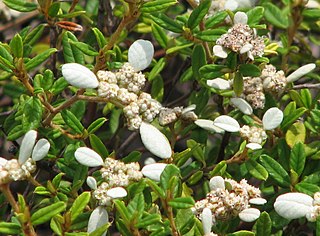
Spyridium vexilliferum, commonly known as winged spyridium, or helicopter bush, is a species of flowering plant in the family Rhamnaceae and is endemic to south-eastern Australia. It is a small, low-lying to erect shrub with linear to narrowly elliptic leaves, and dense heads of small white flowers.

Pimelea humilis, also known as common riceflower or dwarf riceflower, is a species of flowering plant in the family Thymelaeaceae and is endemic to south-eastern Australia. It is an erect or scrambling shrub with hairy stems, elliptic to lance-shaped leaves and heads of 12 to 52 of creamy-white, bisexual or female flowers.

Geranium potentilloides, belongs to the family Geraniaceae, and is a small prostrate perennial herb that can grow up to 60cm high. The species is commonly referred to as Soft Cranesbill or Cinquefoil geranium.

Scaevola hookeri, commonly known as the creeping fan-flower or alpine fan-flower, is a species of flowering plant in the family Goodeniaceae. It has white or blue flowers with a yellow throat and grows in eastern Australia.

Eucalyptus risdonii, commonly known as the Risdon peppermint, is a species of small tree that is endemic to a small area in southern Tasmania. It has smooth bark, a crown composed mostly of sessile, glaucous, egg-shaped juvenile leaves arranged in opposite pairs. The flower buds are arranged in groups of between nine and fifteen and the fruit are cup-shaped, conical or hemispherical.
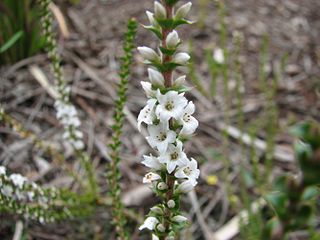
Epacris gunnii is a species of flowering plant in the family Ericaceae and is endemic to south-eastern Australia. It is an erect shrub with hairy branchlets, concave, sharply-pointed, broadly egg-shaped leaves, and tube-shaped, white flowers arranged along the stems.

Bossiaea cordigera , commonly known as wiry bossiaea, is a species of flowering plant in the family Fabaceae and is endemic to southern Australia. It is a straggling shrub with wiry branches, egg-shaped to more or less heart-shaped leaves and yellow and red flowers.
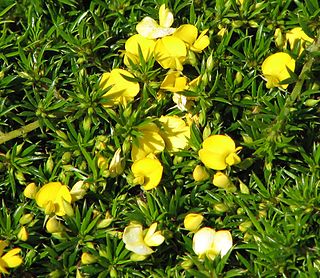
Pultenaea pedunculata, commonly known as matted bush-pea, is a species of flowering plant in the family Fabaceae and is endemic to south-eastern Australia. It is a prostrate, densely matted shrub with softly-hairy branches that often form roots, narrow elliptic leaves, and bright yellow and brick-red flowers.

Hibbertia ericifolia is a species of flowering plant in the family Dilleniaceae and is endemic to south-eastern Australia. It is small, sometimes low-lying to spreading shrub with wiry stems, linear to narrow elliptic leaves, and yellow flowers arranged on the ends of branchlets, with ten to twenty-four stamens arranged around the three carpels.
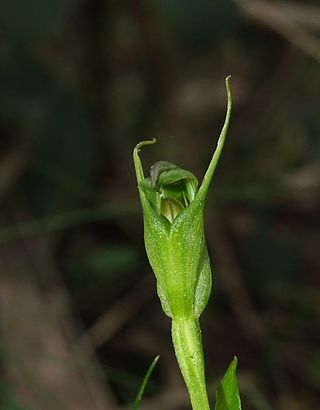
Pterostylis foliata, commonly known as the slender greenhood, is a species of orchid widespread in south-eastern Australia and New Zealand. Flowering plants have a rosette of three to six, dark green, crinkled leaves crowded around the flowering stem and a single dark green and brown flower with a deep V-shaped sinus between the lateral sepals.

Diuris monticola, commonly known as highland golden moths, is a species of orchid that is endemic to south-eastern Australia. It is a common and widespread, late flowering species growing in grassland and woodland habitats at higher altitudes. It has a tuft of up to nine leaves at the base and up to four slightly drooping bright yellow flowers with dark streaks in the centre.

Brachyscome decipiens, commonly known as field daisy, is a perennial herb in the family Asteraceae and is endemic to Australia. It is a small herb with white or pale blue flowers.
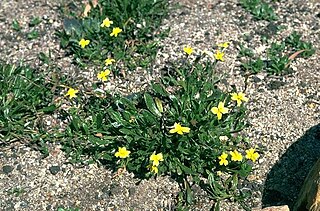
Goodenia geniculata, commonly known as bent goodenia or native primrose, is a species of flowering plant in the family Goodeniaceae and is endemic to south-eastern Australia. It is a low-lying to ascending herb with linear to lance-shaped, often toothed leaves at the base of the plant and racemes of yellow flowers with hairy backs.
Hibbertia hirsuta is a species of flowering plant in the family Dilleniaceae and is endemic to southern Australia. It is a small, slender, prostrate shrub with sparsely hairy foliage, narrow elliptic leaves and small yellow flowers with a single petal, usually only a single stamen and two carpels.

Pultenaea humilis, commonly known as dwarf bush-pea, is a species of flowering plant in the family Fabaceae and is endemic to south-eastern Australia. It is a spreading, often low-lying shrub with branches that are hairy when young, elliptic to lance-shaped leaves with the narrower end towards the base, and yellow to orange and red flowers.
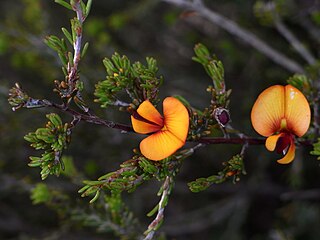
Pultenaea prostrata, commonly known as silky bush-pea, is a species of flowering plant in the family Fabaceae and is endemic to south-eastern Australia. It is a small, rigid, wiry, low-lying or prostrate shrub with cylindrical leaves, and yellow, red and purple-brown flowers.
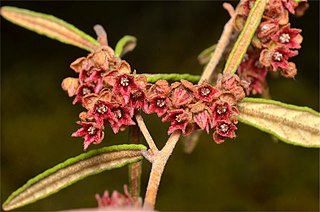
Lasiopetalum membranaceum is a species of flowering plant in the family Malvaceae and is endemic to a small region of eastern Tasmania. It is a low, spreading shrub with thin, rusty-hairy branches, narrow oblong leaves and drooping, star-shaped red to greyish-pink or white flowers.

Pomaderris racemosa is a species of flowering plant in the family Rhamnaceae and is endemic to south-eastern Australia. It is a shrub or small tree with densely hairy branchlets, egg-shaped to broadly elliptic leaves, and racemes or panicles of cream-coloured flowers.

Stenanthemum pimeleoides, commonly known as spreading stenanthemum or propellor plant, is a species of flowering plant in the family Rhamnaceae and is endemic to Tasmania. It is a small, prostrate, mat-forming shrub with hairy young stems, egg-shaped leaves with the narrower end towards the base, and densely hairy clusters of tube-shaped flowers surrounded by conspicuous, whitish floral leaves.




















